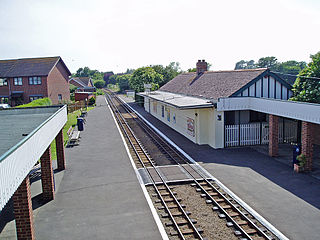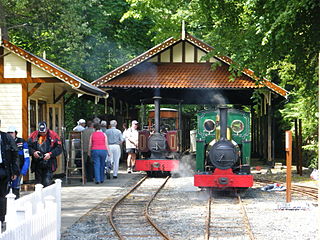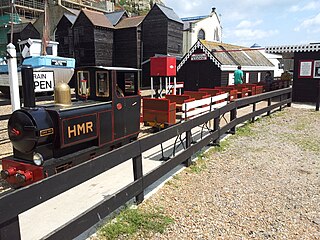
The Romney, Hythe & Dymchurch Railway (RH&DR) is a 15 in gauge light railway in Kent, England, operating steam and internal combustion locomotives. The 13+1⁄2-mile (21.7 km) line runs from the Cinque Port of Hythe via Dymchurch, St. Mary's Bay, New Romney and Romney Sands to Dungeness, close to Dungeness nuclear power station and Dungeness Lighthouse.

Central is a heritage-listed railway station located in the centre of Sydney, New South Wales, Australia. The station is the largest and busiest railway station in Australia and serves as a major transport interchange for NSW TrainLink inter-city rail services, Sydney Trains commuter rail services, Sydney light rail services, State Transit and private bus services, and private coach transport services. The station is also known as Sydney Terminal. The property was added to the New South Wales State Heritage Register on 2 April 1999. It recorded 85.4 million passenger movements in 2018.

The Watercress Line is the marketing name of the Mid-Hants Railway, a heritage railway in Hampshire, England, running 10 miles (16 km) from New Alresford to Alton where it connects to the National Rail network. The line gained its popular name in the days when it was used to transport locally grown watercress to markets in London. The railway currently operates regular scheduled services, along with dining trains, real ale trains and numerous special events throughout the year.

The Downpatrick and County Down Railway (DCDR) is a five-foot, three-inch gauge heritage railway in County Down, Northern Ireland. It is operated by volunteers and runs passenger trains using steam and diesel locomotives, diesel railcars, and vintage carriages. The railway has approximately four miles (6.4 km) of track in a triangular-shaped layout, which connects the town of Downpatrick with the historical sites of Inch Abbey to the north and King Magnus’ Grave to the south. It also houses a museum of railway artefacts and rolling stock originating from both Northern Ireland and the Republic of Ireland, dating from the 1860s to the 1980s.

The Midland Railway – Butterley is a heritage railway at Butterley, near Ripley in Derbyshire.

Newton Abbot railway station serves the town of Newton Abbot in Devon, England. It is 20 miles 13 chains (32.4 km) down the line from Exeter St Davids and 214 miles 5 chains (344.5 km) measured from London Paddington via Bristol Temple Meads, at the junction for the branch to Paignton. The station today is managed by Great Western Railway, who provide the train service along with CrossCountry.

The Wells and Walsingham Light Railway is a 10+1⁄4 in gauge heritage railway in Norfolk, England running between the coastal town of Wells-next-the-Sea and the inland village of Walsingham. The railway occupies a four-mile section of the trackbed of the former Wymondham to Wells branch which was closed to passengers in stages from 1964 to 1969 as part of the Beeching cuts. Other parts of this line, further south, have also been preserved by the Mid-Norfolk Railway.

Dymchurch railway station is on the Romney, Hythe and Dymchurch Railway in Kent, England. It is five miles south of Hythe, and surrounded by flat countryside.

Douglas railway station is the main terminus of the Isle of Man Railway and is located at the landward end of the quay in Douglas, the capital of the Isle of Man. It was once the hub for now closed lines to Peel, Ramsey and Foxdale.

Port Erin railway station is the western terminus of the Isle of Man Railway in the village of Port Erin on the Isle of Man; it is the sole remaining outer terminus of the railway.

Romney Sands Railway Station is a station on the Romney, Hythe and Dymchurch Railway in Kent, England. It is located on the bleakest part of the Romney Marsh, a shingle peninsula.

Barnoldswick railway station was the only railway station on the Midland Railway's 1-mile-64-chain (2.9 km) long Barnoldswick Branch in the West Riding of Yorkshire in England. The line left the Leeds and Bradford Extension Railway at Barnoldswick Junction 55 chains from Earby railway station. The line through the junction was on a 20-chain radius after which it converged to a single track and ran in a straight but undulating line to Barnoldswick. The passenger train that ran back and forth between Barnoldswick and Earby was known locally as the 'Barlick Spud' or 'Spudroaster'. The real reason for the name is lost in time, but the two versions that were commonly recited are that the original branch locomotive was so small it looked like a portable potato roaster used by a local vendor or that the journey time was the same as that taken to roast a potato in the locomotive's firebox.

The Pilot Inn railway station was a station on the Romney, Hythe and Dymchurch Railway in Kent, England.

Bo'ness railway station is a heritage railway station in Bo'ness, Falkirk, Scotland. This station is not the original Bo'ness railway station, which was located roughly a quarter mile west on Seaview Place. The site of the original station is now a car park.

New Romney and Littlestone-on-Sea was a railway station which lay in between the villages of New Romney and Littlestone-on-Sea in Kent, England. The station opened in 1884 and closed in 1967.

Wells on Sea railway station is located in Wells-next-the-Sea, Norfolk on the narrow gauge Wells and Walsingham Light Railway. It was opened in 1982. It is located south of the former level crossing on the A149 Coast Road, close to the former junction with the West Norfolk Junction Railway. The original station, which has been converted to non-rail use, is half a mile closer to the town.

Lhen Coan Station is the landward terminus of the Groudle Glen Railway in the Isle of Man. It is reached by visitors from the nearby Groudle Glen railway station on the Manx Electric Railway.
There were a number of engine sheds and railway works located in York. The large York North engine shed became the National Railway Museum in 1975.

The Hastings Miniature Railway is a 10+1⁄4 in gauge miniature railway located on the seafront at Hastings, a seaside resort, town, and ancient cinque port, in East Sussex, England. Opened in 1948, it remains a popular tourist attraction. The line was re-opened in the summer of 2011 after a period of reconstruction and restoration, which coincided with a forced closure of the eastern part of the line, to facilitate building work on a new art gallery adjacent to the railway.

Bricklayers Arms was a railway station in Southwark opened by the London and Croydon Railway and the South Eastern Railway in 1844 as an alternative to the London and Greenwich Railway's terminus at London Bridge. The station was at the end of a short branch line from the main line to London Bridge and served as a passenger terminus for a few years before being converted to a goods station and engineering facility. The goods station closed in 1981.
























